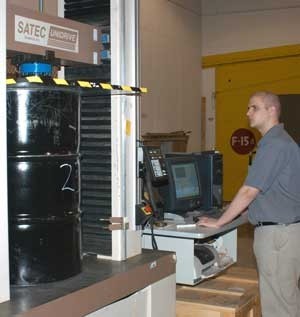
TOBYHANNA ARMY DEPOT, Pa. - A modernization of the Packaging, Storage and Containerization Center's testing laboratory has improved its capabilities as the lead activity for storage and shipping related testing.
The Packaging Applications Testing Facility, part of the U.S. Army Materiel Command's Logistics Support Activity, tests packaging, sealing, identification, storage and container systems for Department of Defense (DoD) and other federal agencies, such as the National Institutes of Health. In accordance with Title 10 US Code A,AS2539b, the lab and testing services are also available for testing requests from the private sector.
At 30,000 square feet, it is the largest packaging applications test facility in DoD, containing $3 million of test equipment. Equipment ranges from small bench-top and walk-in environment simulation chambers, to a 4-ton overhead crane, and an altitude chamber that simulates atmospheric pressures up to 100,000 feet.
Lead activity responsibilities include testing fiberboard and wood boxes, label and identification materials and systems, non-metal pallets, preservatives, adhesives and tapes, and even bags and sacks. Lab engineers and technicians also test processes such as stretch and shrink wrap systems, cold-seal packaging systems and dehumidification systems.
"We test these items and systems for how well they stand up to rough environmental and shipping conditions," says Stuart Crouse, general engineer. "For example, we put containers through several handling and weather-related tests to make sure they don't break, puncture or leak. We can replicate just about any environment or situation a package or container may be subject to."
Crouse noted that the lab supports the Army Transformation effort to give Soldiers needed items in more individual packets, making their load lighter and increasing mobility.
"The lab has been in operation at Tobyhanna for about 40 years and was showing its age," Crouse said.
The renovation was very comprehensive, says Industrial Engineer Charlotte Lent, and included everything from new test equipment to new floor drains. The Packaging Applications Testing Facility now has all the necessary test equipment to provide the full complement of testing required to support the certification of the packaging of hazardous materials for transportation.
"Major construction started in 2001," she said. "We have a new drop plate for dry testing; a tank was installed in the floor of the wet testing area to capture spills from testing 55-gallon drums. The Department of Transportation and DoD organizations send us drums and other packaging systems to test. It's not unusual for some of them to fail catastrophically, so we needed something to contain the spilled contents. Also, we use anti-freeze for tests involving plastics that are to be frozen and needed a way to recover the antifreeze."
Other major improvements include an outside facility where drop tests can be performed from heights of 30 feet or more on containers up to 1,000 gallons, an enclosed dock to provide more lab space for heat generating test equipment (Lent and Crouse noted that there have been unofficial recordings of 220 degrees F in metal containers stored in Southwest Asia and other hot regions), a salt fog generator to test an item's ability to protect equipment from corrosion, and ultraviolet (UV) light equipment to simulate sunlight. The UV light system can be used in conjunction with condensation to test materials for fading, such as stenciling.
"We have a 12,000 pound vibration table that can change amplitude and frequency while in motion," Crouse said. "Along with an incline impact tester, that is a capability not many labs like ours have. Most of our equipment is computer controlled, and we can see and record test data."
"And although our 14- and 7-foot revolving drums are not new, they give us an extra evaluation tool no one else has," Lent added.
A security system was installed so the lab can conduct tests of classified or proprietary materials or systems, as well as anything that may require around-the-clock surveillance. A test of M-16 rifle bag designs involved M-16 rifles that had to be secured after every test.
Other improvements include a wheelchair accessible entry with a ramp, a conference area, and new offices.
"The entire personnel area was modernized," Crouse said. "We have better lighting throughout the facility; even the walls were renovated."
Lent and Crouse noted that PSCC implemented several Lean concepts, organizing lab areas and tools to further improve efficiency.
As technological advances in materials and processes continually come about, the LOGSA PSCC Packaging Applications Testing Facility stands ready to support the Soldier through testing that ensures items get to the field in the intended condition for use.

Social Sharing